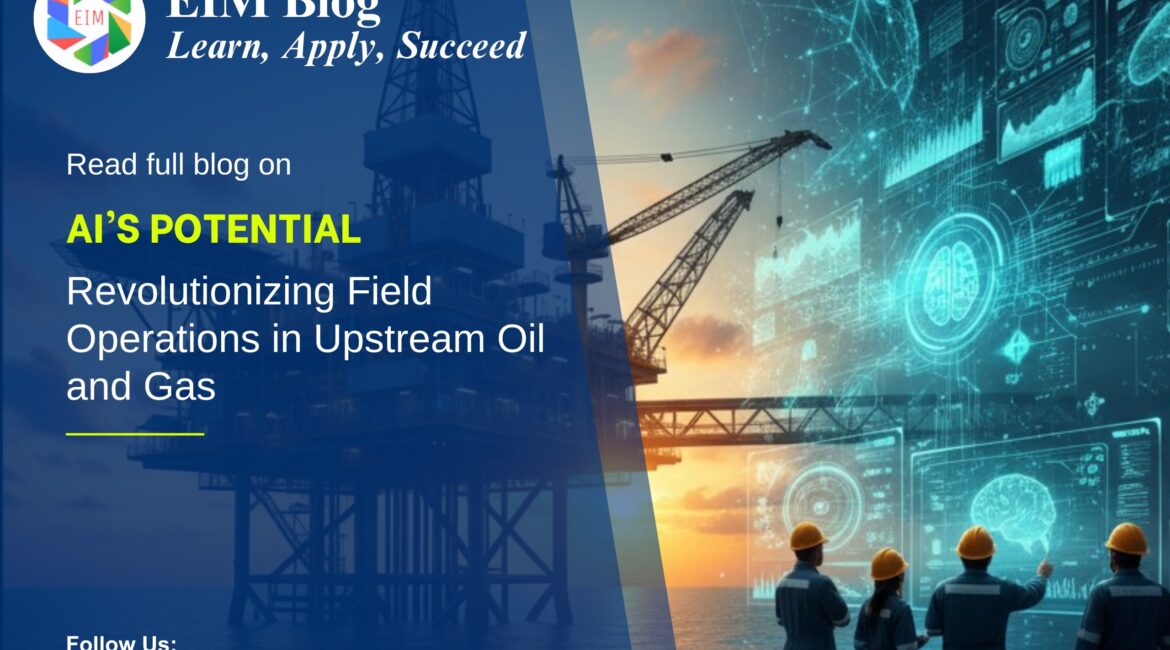
AI’s Potential: Revolutionizing Field Operations in Upstream Oil and Gas
The oil and gas industry has always been driven by technological innovation, but the rapid rise of Artificial Intelligence (AI) is transforming operations at an unprecedented pace—particularly in upstream exploration and production (E&P). From automating data analysis to optimizing drilling operations, AI is enabling energy companies to make smarter, faster, and safer decisions.
In a highly competitive and volatile market, where every decision impacts profitability, AI in oil and gas is no longer optional—it’s essential. Let’s explore how AI is revolutionizing upstream operations, reshaping exploration, drilling, and production for a more efficient and sustainable energy future.
1. Understanding Upstream Operations
The upstream segment of the oil and gas industry involves the exploration, drilling, and extraction of crude oil and natural gas. These processes are complex, data-intensive, and capital-heavy. Companies face challenges like:
-
High exploration risks and uncertainty
-
Equipment downtime and maintenance costs
-
Fluctuating oil prices
-
Environmental and safety compliance
To overcome these, operators are turning to AI-driven solutions that analyze massive data sets, predict equipment behavior, and optimize resource utilization in real-time.
2. AI’s Role in Transforming Upstream Operations
AI technologies like machine learning (ML), predictive analytics, computer vision, and natural language processing (NLP) are bringing digital intelligence to oilfields. These technologies help companies move from reactive to proactive operations—reducing downtime, cutting costs, and improving decision-making.
Key Applications of AI in Upstream Oil and Gas
-
Exploration and Reservoir Management
-
AI models analyze seismic data and geological patterns to identify potential drilling sites faster and more accurately than traditional methods.
-
Machine learning algorithms improve reservoir modeling, helping geologists estimate reserves and optimize recovery rates.
-
-
Drilling Optimization
-
AI monitors drilling parameters in real time, predicting issues like drill bit wear, mud loss, or pressure anomalies before they cause downtime.
-
Advanced algorithms help design efficient drilling paths, minimizing non-productive time (NPT).
-
-
Production Forecasting and Optimization
-
Predictive models use historical data and real-time inputs to forecast production output and optimize well performance.
-
AI tools adjust parameters automatically to maximize yield while minimizing energy use and equipment strain.
-
-
Predictive Maintenance
-
AI-powered monitoring systems detect anomalies in pumps, compressors, and valves, predicting failures before they occur.
-
This reduces maintenance costs and improves equipment reliability, saving millions annually.
-
-
Health, Safety, and Environment (HSE) Management
-
Computer vision tools powered by AI detect safety violations, gas leaks, or equipment malfunctions through real-time video monitoring.
-
AI also assists in environmental monitoring by analyzing emissions data and identifying irregularities early.
-
3. AI-Driven Data Analytics: The New Oil
Data is the new crude, and AI is the refinery that extracts value from it. Every upstream operation—from seismic surveys to drilling logs—generates terabytes of data daily.
AI in Data Integration and Analysis
-
Machine learning enables integration of structured and unstructured data from multiple sources (sensors, SCADA systems, drones, etc.).
-
Cognitive analytics uncovers hidden correlations and trends, guiding decision-makers toward optimal operational strategies.
-
Digital twins—AI-powered virtual models of physical assets—simulate operations and predict performance, reducing trial and error.
By turning raw data into actionable insights, AI helps upstream companies enhance efficiency, reduce risk, and extend asset life.
4. The Rise of the Digital Oilfield
AI forms the backbone of the digital oilfield—a concept that integrates real-time data, automation, and analytics to optimize field operations.
Key Features of Digital Oilfields Powered by AI
-
Automated drilling systems that adjust parameters instantly based on sensor feedback
-
Real-time production dashboards integrating IoT and AI analytics
-
Autonomous inspection drones for remote monitoring of pipelines and offshore rigs
-
AI-assisted collaboration tools that enhance decision-making across geoscientists, engineers, and field operators
Companies like BP, Shell, and ExxonMobil have already deployed digital oilfields using AI and machine learning to achieve safer and more efficient operations.
5. Real-World Case Studies
1. Shell’s Predictive Maintenance System
Shell uses AI-based predictive maintenance across its upstream assets. Machine learning models analyze sensor data from compressors, pumps, and turbines to predict failures. This system has reduced unplanned downtime by nearly 50%, saving millions in lost production.
2. BP’s Partnership with Beyond Limits
BP partnered with Beyond Limits to integrate cognitive AI technology that simulates human reasoning in reservoir management. This allows geoscientists to interpret subsurface data faster, leading to smarter exploration and drilling strategies.
3. Equinor’s Digital Twin Technology
Equinor (formerly Statoil) uses AI-powered digital twins to simulate offshore platforms. The digital replica continuously learns from sensor data, predicting operational issues and optimizing maintenance schedules.
6. Sustainability and Energy Transition
AI not only boosts operational efficiency but also supports the energy transition by helping companies reduce their carbon footprint.
-
Emission Monitoring: AI detects leaks and monitors greenhouse gas (GHG) levels in real time.
-
Energy Optimization: AI algorithms balance power consumption in drilling and pumping operations, cutting unnecessary energy use.
-
Carbon Capture Efficiency: AI models enhance the performance of carbon capture, utilization, and storage (CCUS) systems.
As sustainability becomes a core business priority, AI in upstream operations is helping oil companies align with global ESG (Environmental, Social, and Governance) goals.
7. Challenges in AI Adoption
Despite its potential, integrating AI in upstream oil and gas comes with challenges:
-
Data Quality Issues: Inconsistent, incomplete, or siloed data limits AI model accuracy.
-
Skill Gaps: Many field operators lack the technical expertise to manage AI systems effectively.
-
Integration Complexity: Combining AI with legacy systems requires significant investment.
-
Cybersecurity Risks: As data connectivity increases, so does the exposure to cyber threats.
However, companies that overcome these challenges stand to gain significant operational and financial advantages.
8. The Future of AI in Upstream Oil and Gas
The next decade will see AI advancing beyond automation into autonomous operations. Future trends include:
-
AI-driven autonomous drilling rigs capable of self-adjustment and self-learning.
-
Advanced robotics and drones for hazardous field inspections.
-
Generative AI models that predict new exploration zones using historical geological data.
-
Hybrid cloud-AI ecosystems for real-time collaboration between field teams and control centers.
With increasing digital maturity, the AI-powered upstream sector will be more resilient, efficient, and environmentally responsible.
Conclusion
AI is no longer just a buzzword—it’s a strategic enabler for upstream oil and gas operations. By leveraging AI-driven analytics, predictive maintenance, and digital twin technologies, companies can significantly improve productivity, safety, and sustainability.
As the world transitions toward cleaner energy, AI will play a pivotal role in balancing traditional hydrocarbon production with environmental responsibility.
In short, AI is redefining the future of upstream oil and gas, helping companies discover smarter, operate safer, and perform better





